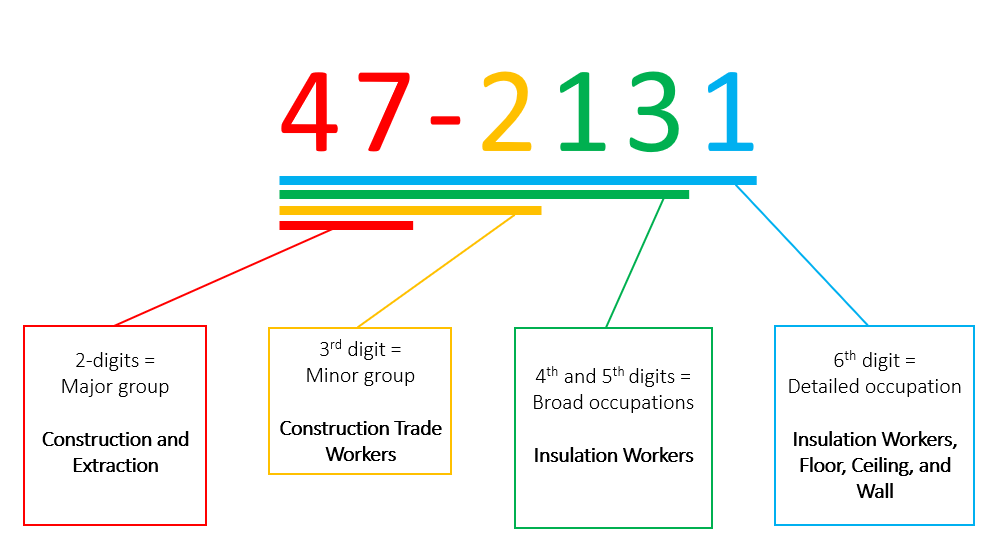At a glance
- Classification systems ensure standardized numeric codes are assigned to occupation and industry descriptions. This coding process prepares data for analysis.
- This page provides an overview of the three main occupation and industry classification systems used in the United States.
- Access non-Census codes for military and non-paid workers. Census does not have standard codes for these two groups of workers.
Standard Occupational Classification
Standard Occupational Classification (SOC) is used to assign occupation codes. The occupations in SOC do not relate to any industry code. The U.S. Bureau of Labor Statistics (BLS) updates SOC codes every 10 years (get information about crosswalks).
All occupations are organized into one of 23 major groups. SOC codes may be up to 6-digits.
- First 2-digits: Major group
- 3rd digit: Minor group
- 4th and 5th digits: Broad occupations
- 6th digit: Detailed occupations
Example
47-2131 is the SOC code for Insulation Workers, Floor, Ceiling, and Wall
SOC code 47-2131 breaks down as follows:

North American Industry Classification System
North American Industry Classification System (NAICS) is used to assign industry codes.
NAICS codes are updated every 5 years by the Office of Management and Budget (OMB) to include industry and economic changes (get information about crosswalksA).
All industries are organized into one of 20 Sectors. NAICS codes may be up to 6-digits.
- First 2-digits: Sector
- 3-digit code: Subsector
- 4-digit code: Industry group
- 5-digit code: NAICS industry group
- 6-digit code: National industry
Each digit in the code is part of a series of progressively narrower industry groups. The greater number of digits in the code, the greater the classification detail.
Example
561730 is the 6-digit NAICS code for the industry Landscaping Services
NAICS code 561730 breaks down as follows:

Census classification system
Census can be used to assign both occupation codes and/or industry codes. Census occupation codes and Census industry codes are often used as a pair. Census codes were developed to code surveys sponsored by the Census Bureau and protect respondent privacy.
Within the Census classification system, industry is coded first, then occupation. This is because the Census industry code sometimes limits which occupation codes may be included in an industry.
The Census occupation codes differ by industry:


Census occupation codes are derived from SOC. Census industry codes are derived from NAICS. However, Census occupation and industry codes are less detailed than the SOC or NAICS codes to protect respondents participating in Census or health surveys.
Example: How Census occupation codes relate to SOC codes
Census occupation code for Other Physicians is 3090.
Census code 3090 maps to multiple SOC codes, including:
- Family medicine physicians (29-1215)
- Dermatology (29-1213)
- Cardiology (29-1212)
Example: How Census industry codes relate to NAICS codes
Census industry code for Construction is 0770.
Census code 0770 maps to multiple NAICS codes, including:
- Roof Contracting (NAICS 238160)
- House Painting Contracting (NAICS 238320)
- Building Contractor (NAICS 238120)
Crosswalk coding is the mapping of a code from one occupation and industry classification system to another or to a different code within the same occupation and industry classification system for a different year. SOC and NAICS are regularly revised. Census codes are revised following NAICS and SOC revisions. Crosswalks can be found on the Census website.
See the Alphabetical Indexes of Industries and Occupations, which are comprehensive lists of specific occupation and industry titles used to describe Census occupation and industry codes.
Census occupation and industry classification system
The CDC Census occupation and industry classification system does NOT provide codes for military or non-paid workersB. Therefore, NIOSH and NCHS created codes for these to supplement the Census classification system. This code set is often referred to as the "CDC Census" or the "NIOSH/NCHS military and non-paid worker codes".
Please email us if you have questions about CDC Census.
These code sets are available here:
NIOSH's Industry and Occupation Computerized Coding System (NIOCCS) assigns "NIOSH/NCHS military and non-paid worker codes". Again, please note that these are NOT Census codes, so they won't be found in Census documentation.
These codes have changed over time for a few reasons. Census assigned actual occupations or industries to codes we used previously. Census changed to 4-character codes in 2002; therefore, the "NIOSH/NCHS military and non-paid worker codes" were also changed to 4-characters codes.
The following filesCinclude (1) the Census Occupation and Industry Classification system codes, (2) the corresponding NAICS/SOC codes, and the (3) NIOSH/NCHS military and non-paid worker codes.
- To find crosswalks for NAICS, visit the Census website and under the Section entitled "Reference Files," click on "Concordances."
- Non-paid workers include housewives, volunteers, students, and those without enough information to assign Census codes.
- Learn more about variations by year on the Census Bureau website.
- Crosswalks can be found on the BLS SOC website.


